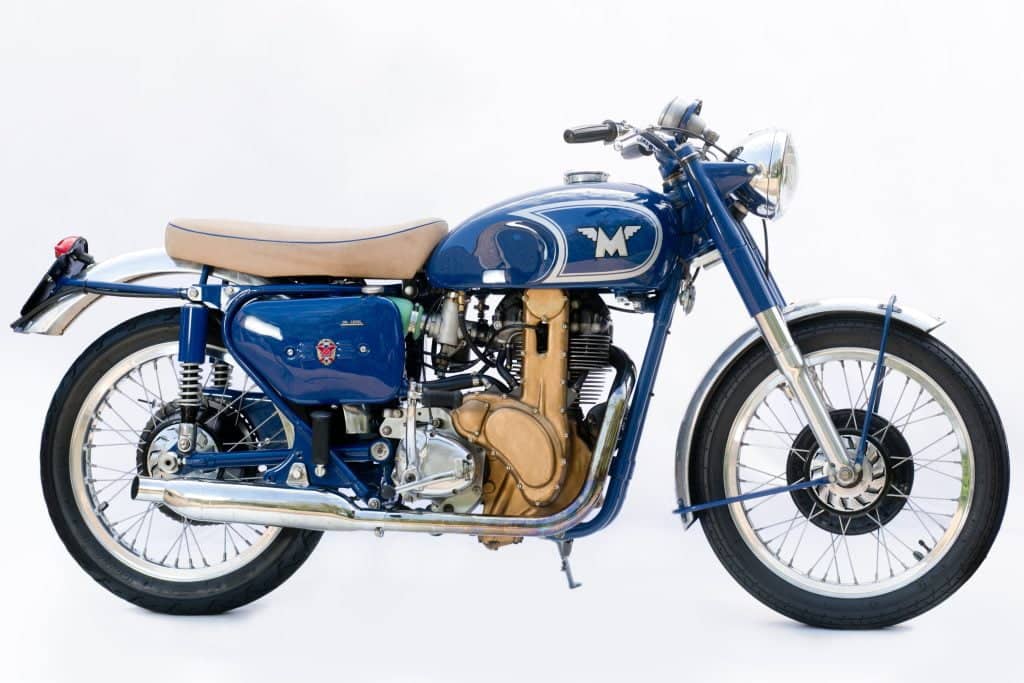
Back in 1962, there was an eye-catching ‘street scrambler’ styled motorcycle in the Matchless road bike range. It was listed as the G50 CSR Silver Eagle and apparently destined mainly for the American market. That was indeed the case but it was never intended to sell in any quantity in that or any other marketplace.
It was a ‘homologation special’. Designed purely and simply as a way of getting the 500cc single-cylinder, overhead-camshaft Matchless G50 racing engine approved for the American Grand National Championship series.

American Motorcycle Association
That series was run to the ‘Class C’ rules of the American Motorcycle Association. These stipulated that competing machines should be based on production road-going motorcycles offered to the general public.
The G50 engine, however, was only used in Matchless race bikes. So some rule-bending was needed!
The bike in its Matchless G50 CSR form, as pictured in their catalogue, was duly homologated by the AMA for 1962 competition. It was based on that brochure listing and the provision of the necessary 25 models shown to the AMA to complete the process.
The Silver Eagle
But neither the Matchless factory in Britain nor its US importers, ever had any intention whatsoever of putting the ‘Matchless G50 CSR Silver Eagle’ on sale as a road bike. And neither did they ever have any intention of racing it in its alleged ‘production’ form.
And it’s not even certain whether the required 25 bikes were actually completed. One version of the Matchless G50 CSR story has it that the homologation committee members were shown a handful of completed bikes plus a number of G50 engines and a line-up of frames and running gear into which those engines were “going to be fitted…”
That tale (admittedly an unsubstantiated one) has it that, as soon as the bike was approved for racing, those frames were fitted with the standard singles and twins that had been destined for them all along! All of these used the less effective pushrod-operated valve gear and would not have been competitive on the racetrack.
Associated Motorcycles
Certainly, that plan could well have been employed by Matchless as its parent company, Associated Motorcycles Ltd. They did have previous ‘form’ in the rule-bending department. Another famous marque in the AMC portfolio was that of Norton. In 1950 Billy Matthews had won the prestigious Daytona 200 Miles Race using one of the most famous race engines the world has ever known. A single-cylinder double overhead-camshaft 500cc Manx Norton.
Norton’s use of the then-new twin-cam engine was of distinctly questionable legality as the Daytona rules restricted competing machines to those based on production road bikes. AMC had gotten around this by listing the twin-cam cylinder head as an optional extra for its single-overhead camshaft engine used in the Norton International street bike!
In reality, there was no way the twin-cam head would fit the road-going engine but Norton sneakily listed it in its catalogue. The American Motorcycle Association took its word as fact rather than the fiction that it was.

Optional Equipment
With the Matchless G50 CSR a dozen years later, AMC used the same tactic but this time stretched the ‘optional equipment’ allowance to quite frankly ridiculous limits.
On getting the G50 CSR approved by the AMA AMC then immediately listed the real G50 racing chassis, forks, brakes, tank, seat, etc. etc. etc. as ‘optional special equipment’ for the G50CSR!
No Matchless G50 CSR as shown in the AMC catalogue ever appeared on an American road race track. Instead, thanks to its massive ‘optional equipment’ list quoted by AMC for the CSR, the actual G50 Grand Prix racer was eligible to compete in the production bike-based American Grand National Series. This was surely one of the most breathtakingly obvious pieces of rule-bending ever seen in any form of production-based racing.
No wonder Harley Davidson and the British importers were disgruntled – if not incensed! Harley was still running basically the same side-valve vee-twins as its street bikes while BSA racers, whether singles or twins and the twin-cylinder Triumphs were all using pushrod–operated valve gear for the overhead-valve engines from their road-going ranges. Now along came Matchless with a fully-developed overhead-camshaft engine. A proper racing motorcycle that was regularly scoring points in Grand Prix races – just because some clever chap in the Matchless marketing department had closely studied the AMA rule book.
Road Racing
The G50CSR ‘road bike’ was created purely as a ruse to get the G50 racer into US road racing. The ultimate goal was a win in the important Daytona 200. Success at Daytona would guarantee big sales of any machines in the winning brand’s showrooms. And the Matchless ploy was oh-so-close to succeeding.
When Dick Mann took to the track for the 1962 Daytona 200, he was actually on a complete G50 racer just like those being used in Europe. These had been a force to be reckoned with in the 500cc class in UK competition since 1958. Nowhere in the Daytona paddock could a G50CSR be seen!
Dick was consistently the fastest man on the track in the Daytona race but stalled his engine after his refueling pit stop. This allowed Don Burnett on a Triumph to get a lead of more than 30 seconds. For lap after lap, Mann and the G50 reeled in the Triumph. It came up just 10 feet short in what is still reckoned to be the closest finish in Daytona history! Divine justice, perhaps?

This was the G50 Grand Prix racer with which Dick Mann so nearly won the 1962 Daytona 200. Very different from the G50CSR thanks to the ‘optional equipment’ package
1963 onwards
By the end of that 1962 season the AMA officials had realised that Matchless had pulled a fast one on them. It was undoubtedly prompted by those aforementioned very vocal complaints from the other manufacturers involved in the Grand National Series. They banned the G50 engine from competition unless it ran in the motorcycle that had originally been presented to them. I.e. the G50 CSR.

In that form, of course, it had been properly homologated. It was the ‘special equipment’ (i.e. the complete rolling chassis of a G50 racer!) that was the problem. Not surprisingly, the G50CSR version was never seen in American national racing.
And the G50CSR certainly was never put on the road in any quantities. Certainly, no more than 25 were ever built. Many insiders who were there in the USA reckon the real number was less than half of that. That, of course, is why it has always been such a tantalizingly interesting machine….
How many G50 CSRs are known to exist
Four are known to still exist. Three in the USA and, at the time of writing this, the one in Britain’s National Motorcycle Museum.
There is evidence that the AMA quickly relaxed its ruling against the G50 in racing. After sitting out the year of the ban (1963) Matchless again began appearing in the Daytona 200 results. This means approval must have been given for the G50 in full racing trim. Possibly the rules had changed so that, as long as the actual number of bikes had been built to satisfy the homologation requirements, there was no need for them to be based on road machines.
Anyway, in 1964 G50 riders Dick Klamfoth and Everett Brashear finished fifth and sixth respectively. Dick Mann was G50-mounted again in 1965 and placed fifth. Ralph White was fourth in 1966, riding for the official Matchless team run by Bob Hansen. Bob, of course, would go on to run the Kawasaki US team in 1972.
In 1967, young California star, Swede Savage, was the Team Hansen rider and placed 11th on a G50. He then successfully switched to car racing but sadly was to die in the Indianapolis 500 three years later.
In a final note of interest to British fans, in 1968 Peter Williams made the trip to Florida and finished eighth. It marked the final appearance for a Matchless G50 in the Daytona 200.
If you’re a member of the AJS & Matchless Owners Club, we’d love to hear from you! Speak to a member of our friendly team on 0121 274 5374 to get a quote.
If you’re interested in joining the club, please visit: AJS & Matchless Owners Club
Words: Bruce Cox
Photographs courtesy of Bonhams Auctions USA



